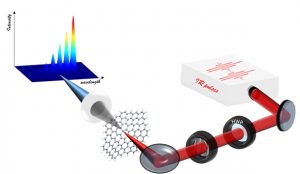
High Harmonic Generation in 2D Structures
High harmonic generation (HHG) is presented as one of the sources for coherent UV and x-ray radiation with attosecond pulse durations. HHG in gases has been well studied and reported for decades, however, in solids, it was first observed in 2011 and is now extensively investigated. HHG in solids was reported in a number of materials such as semiconductors, and 3D structures including bow-tie structures, nanoantennas and nanocones.
|
Another interesting materials are 2D structures such as graphene and hexagonal boron nitride (h-BN) that exhibit unique structural and optical properties. Two dimensional structures, such as those extraordinary materials, have also proved to generate efficient harmonics. Not only they are used as a medium of generation, but the behavior of the harmonics signal reveals information about the structural properties of the material such as its band structure. Here, we investigate HHG in 2D materials. |
 |
| • Collaboration : |
Marc Hanna, IOGS (Palaiseau) Prof. Milutin Kovacev, Leibniz Universität (Hannover) Nicolas Ducros (NOVAE), Sébastian Février (XLIM) |
|
| • People : |
Shatha Kaassamani Dominik Franz David Gauthier |
|
| • Publications | ||
| • Fundings |
ANR (PACHA, IPEX) PALM (HILAC, PlasmonX, STAMPS) |


